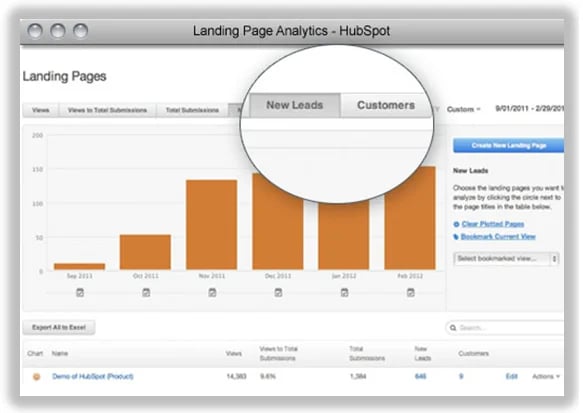

This is an excerpt from our new ebook, How to Unlock the ROI of Your Marketing Analytics . Download your free copy if you want to learn more about using data to make actionable improvements to your marketing.
Successful inbound marketers don’t make decisions based on feelings -- their decisions are based on data. But where does that data come from? Why, their marketing analytics, of course!
But just collecting data isn't enough. Effective marketers track important data points, analyze what they mean, and then use that knowledge to make actionable improvements. After all, what's the point of having a bunch of juicy data if it can't make you a better marketer?
So we're going to dive into some core lead nurturing metrics and explain how you can use them to measure and improve the performance of your campaigns -- which generates more leads and customers!
Important Lead Nurturing Metrics
Before we get started, let's review the 4 important metrics you should have handy in your analytics tools to measure your lead nurturing performance.
- Click-Through Rates - the proportion of the audience who clicked on one or more links contained in a lead nurturing email message
- Conversion Rates - the percentage of recipients who clicked on a link within an email and completed a desired action
- Time to Customer Conversion - the length of time it takes for a lead to become a customer
- Cost per Customer - the marketing cost of acquiring a new customer
Click-Through and Conversion Rates
The effectiveness of your lead nurturing is dependent on how well you’ve segmented your leads. Dive in to your analytics tool to identify any problems with your list segmentation. Start by looking at your unsubscribe rate, which should stay below 1% at all times. If it’s higher for any particular list segment, this is an indication that the content you're sending isn’t relevant to that list segment, and recipients are unsubscribing as a result. You can glean similar insights by examining the click-through rates of each list segment. Marketers who suffer a low click-through rate for a particular list segment haven’t aligned their offer well with the recipients on that list.
Faulty list segmentation can be remedied by revisiting how you’ve mapped content to your list segments based on their stage in the sales cycle. Deliver email content to leads based on the pages they’ve visited on your site, the content they’ve downloaded, the blog posts they’ve commented on, and how far down the sales funnel they are. (Learn more about how to map lead nurturing content in this comprehensive blog post on the subject.) You can optimize the offers you deliver by analyzing which CTAs have the highest click-through rate, and which landing pages have the highest visitor-to-customer conversion rate in your closed-loop analytics. For HubSpot customers, for example, you can find this information in your Landing Page Analytics.

Time to Customer Conversion
You should always be looking for ways to make your lead nurturing more efficient. To improve your time to customer conversion, analyze how effective you are at generating marketing qualified leads (MQLs) with your lead nurturing.
MQLs are the leads that are more likely to become customers based on their pre-close activities -- read this blog post if you haven't defined an MQL for your business yet. But if you’ve implemented lead nurturing effectively, more leads should be moving to the MQL stage of the sales funnel. Analyze this for each lead nurturing campaign -- you may find that some list segments move more slowly than others, indicating you have a bottleneck in your lead nurturing somewhere. Revisit the content and offers you’re using for that list segment. You may be sending less-than-compelling offers, or pointing leads to under-optimized landing pages.
You can also improve your time to customer conversion by looking at the number of sales-accepted leads in each lead nurturing campaign. Marketing automation should increase not just your number of MQLs, but also the number of sales-accepted leads. If this is not the case, meet with your sales organization to diagnose the problem. This is often a result of misaligned lead scoring criteria between Sales and Marketing. But by fixing it, you should see your time to customer conversion decrease as Sales reaches out to leads that have reconverted enough to provide the quality information needed to close sales.
Cost per Customer
Effective lead nurturing converts leads into MQLS and sales-accepted leads, but it must follow through all the way to customer conversion. Use closed-loop analytics to ensure the leads you’re nurturing actually turn into customers, and they do so at an efficient cost. Remember, your end goal as a marketer is not to generate leads, it's to generate customers -- and at the most efficient cost possible.
Over time, your cost per customer should decrease as more leads that typically bleed out of the top of the funnel are adequately nurtured down through the bottom of the funnel – until they are finally converted into a customer. Check this metric monthly to ensure your lead nurturing efforts stay cost-efficient.
How do you use marketing analytics to improve the performance of your lead nurturing?

Lead Nurturing










![How to Expand Your Lead Nurturing Strategy Beyond Just Email [SlideShare]](https://53.fs1.hubspotusercontent-na1.net/hub/53/file-1390659247-jpg/Blog_Thinkstock_Images/lead_nurturing.jpg)
